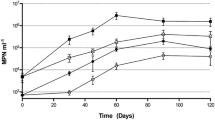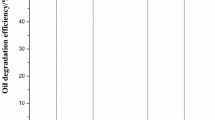Abstract
Marine waters are most vulnerable to crude oil pollution due to increased sea-based oil-related activities. Successful remediation of such polluted environments is normally carried out in a laboratory with suitable physical and environmental alterations. However, it is challenging to alter the physical and environmental conditions in crude oil-contaminated natural environments. In a previous study, six hydrocarbonoclastic bacteria were isolated from an oil-contaminated site. Here we report on their ability to mineralise weathered crude oil as a carbon source in seawater mesocosms, in order to construct a hydrocarbonoclastic consortia for the effective mineralisation of hydrocarbons present in the weathered crude oil at seawater-based environment. This was completed without altering the physical and environmental parameters (salinity, pH and temperature) and followed by the detection of microbial community changes. The total amount of oil mineralised by these six isolates individually over 28-day incubation ranged from 4.7 to 10 %. The bacterial consortia composed of these six strains showed a greater mineralisation rate (18.5 %). Temperature gradient gel electrophoresis revealed that the functionally dominant species were present after the first week (week 2 to week 4) following the addition of the consortia, which were represented in dendrogram by cluster 2 and also these weeks representing a distinct point on the Pareto–Lorenz curve; no community could be identified in controls in which no consortia were added. This shows that the addition of consortia potentially dealt with changing environmental conditions and preserved its functionality followed by effective mineralisation of weathered crude oil.





Similar content being viewed by others
References
Alvarez, P. J. J., & Illman, W. A. (2006). Bioremediation and natural attenuation. New Jersey: Wiley.
Aspray, T. J., Carvalho, D. J. C., & Philip, J. C. (2007). Application of soil slurry respirometry to optimise and subsequently monitor ex situ bioremediation of hydrocarbon-contaminated soils. International Biodeterioration and Biodegradation, 60, 279–284.
Aspray, T., Gluszek, A., & Carvalho, D. (2008). Effect of nitrogen amendment on respiration and respiratory Quotient (RQ) in three hydrocarbon contaminated soils of different type. Chemosphere, 72, 947–951.
Atlas, R. M., & Philip, J. (2005). Applied microbial solutions for real-world environmental cleanup. Washington: ASM.
Betti, M., Boisson, F., Eriksson, M., Tolosa, I., & Vasileva, E. (2011). Isotope analysis for marine environmental studies. International Journal of Mass Spectrometry, 307, 192–199.
Bordoloi, N. K., & Konwar, B. K. (2008). Microbial surfactant-enhanced mineral oil recovery under laboratory conditions. Colloids and Surfaces, 63, 73–82.
Bushnell, L. D., & Haas, H. F. (1941). The utilization of certain hydrocarbons by microorganisms. Department of Bacteriology, 199, 653–673.
Cappello, S., Denaro, R., Genovese, M., Giuliano, L., & Yakimov, M. M. (2007). Predominant growth of Alcanivorax during experiments on “oil spill bioremediation” in mesocosms. Microbial Research, 162, 185–190.
Chang, W., Whyte, L., & Ghoshal, S. (2011). Comparison of the effects of variable site temperatures and constant incubation temperatures on the biodegradation of petroleum hydrocarbons in pilot-scale experiments with field-aged contaminated soils from a cold regions site. Chemosphere, 82, 872–878.
Diplock, E. E., Mardlin, D. P., Killham, K. S., & Paton, G. I. (2009). Predicting bioremediation of hydrocarbons: laboratory to field scale. Environmental Pollution, 157, 1831–1840.
Falk, M. W., Song, K., Matiasek, M. G., & Wuert, S. (2009). Microbial community dynamics in replicate membrane bioreactors—natural reproducible fluctuations. Water Research, 43, 842–852.
Fantroussi, E. S., & Agathos, S. N. (2005). Is bioaugmentation a feasible strategy for pollutant removal and site remediation. Current Opinion in Microbiology, 8, 268–275.
Ferguson, S. H., Franzmann, P. D., Revill, A. T., Snape, I., & Rayner, J. L. (2003). The effects of nitrogen and water on mineralisation of hydrocarbons in diesel-contaminated terrestrial Antarctic soils. Cold Regions Science and Technology, 37, 197–212.
Fingerman, M., & Nagabhushanam, R. (2005). Bioremediation of aquatic and terrestrial ecosystems. New Hampshire: Science.
Fiuza, A. M. A., & Vila, M. C. C. (2005). An insight into soil bioremediation through respirometry. Environment International, 31, 179–183.
Frutos, F. J. G., Escolano, O., Garcia, S., Babin, M., & Fernandez, M. D. (2010). Bioventing remediation and ecotoxicity evaluation of phenanthrene-contaminated soil. Journal of Hazardous Materials, 183, 806–813.
Gejlsbjerg, B., Madsen, T., & Andersen, T. T. (2003). Comparison of biodegradation of surfactants in soils and sludge–soil mixtures by use of 14C-labelled compounds and automated respirometry. Chemosphere, 50, 321–331.
Girvan, M. S., Bullimore, J., Pretty, J. N., Osborn, A. M., & Ball, A. S. (2003). Soil type is the primary determinant of the composition of the total and active bacterial communities in Arable soils. Applied and Environmental Microbiology, 69, 1800–1809.
Kadali, K. K., Simons, K. L., Skuza, P. P., Moore, R. B., & Ball, A. S. (2012). A complementary approach to identifying and assessing the remediation potential of hydrocarbonoclastic bacteria. Journal of Microbiological Methods, 2012, 348–355.
Lal, B., & Khanna, S. (1996). Degradation of crude oil by Acinetobacter calcoaceticus and Alcaligenes odorans. The Journal of Applied Bacteriology, 81, 355–362.
Leahy, J. G., & Colwell, R. R. (1990). Microbial degradation of hydrocarbons in the environment. Microbiological Reviews, 54(3), 305–315.
Lloyd-jones, G., Laurie, A. D., Hunter, D. W. F., & Fraser, R. (1999). Analysis of catabolic genes for naphthalene and phenanthrene degradation in contaminated New Zealand soils. FEMS Microbiology Ecology, 29, 69–79.
Lovely, D. R. (2003). Cleaning up with genomics: applying molecular biology to bioremediation. Nature Reviews Microbiology, 1, 35–44.
Margesin, R., Labbe, D., Schinner, F., Greer, C. W., & Whyte, L. G. (2003). Characterization of hydrocarbon-degrading microbial populations in contaminated and pristine Alpine soils. Applied and Environmental Microbiology, 69, 3089–3092.
Marzorati, M., Wittebolle, L., Boon, N., Daffonchio, D., & Verstraete, W. (2008). How to get more out of molecular fingerprints: practical tools for microbial ecology. Environmental Microbiology, 10, 1571–1581.
Mckew, B. A., Coulon, F., Osborn, A. M., Timmis, K. N., & McGenity, T. J. (2007). Determining the identity and roles of oil-metabolizing marine bacteria from the Thames Estuary, UK. Environmental Microbiology, 9(1), 165–176.
Miles, R. A., & Doucette, W. J. (2001). Assessing the aerobic biodegradability of 14 hydrocarbons in two soils using a simple microcosm/respiration method. Chemosphere, 45, 1085–1090.
Minai-Tehrani, D., Minoui, S., & Herfatmanesh, A. (2008). Effect of salinity on biodegradation of polycyclic aromatic hydrocarbons (PAHs) of heavy crude oil in soil. Bulletin of Environmental Contamination and Toxicology, 82, 179–184.
Muyzer, G. (1999). DGGE/TGGE a method for identifying genes from natural ecosystems. Current Opinion in Microbiology, 2, 317–322.
Muyzer, G., & Smalla, K. (1998). Application of denaturing gradient gel electrophoresis (DGGE) and temperature gradient gel electrophoresis (TGGE) in microbial ecology. Antonie Van Leeuwenhoek, 73, 127–141.
Muyzer, G., De Waal, E. C., & Uitterlinden, A. G. (1993). Profiling of complex microbial populations by denaturing gradient gel electrophoresis analysis of polymerase chain reaction-amplified genes coding for 16 S rRNA. Applied and Environmental Microbiology, 59, 695–700.
Nocker, A., Burr, M., & Camper, A. K. (2007). Genotypic microbial community profiling: a critical technical review. Microbial Ecology, 54, 276–289.
Osborn, A. M., Moore, R. B., & Timmis, K. N. (2000). An evaluation of terminal-restriction fragment length polymorphism (T-RFLP) analysis for the study of microbial community structure and dynamics. Environmental Microbiology, 2, 39–50.
Perez-Armendariz, B., Martienez-Carrera, D., Calixto-Mosqueda, Alba, J., & Rodriguez-Vazquez, R. (2010). Filamentous fungi removes weathered hydrocarbons from polluted soil of tropical Mexico. Revista Internacional De Contaminacion Ambiental, 26, 193–199.
Plaza, G., Ulfig, K., Worsztynowicz, A., Malina, G., Krzeminska, B., & Brigmon, R. L. (2005). Respirometry for assessing the biodegradation of petroleum hydrocarbons. Environmental Technology, 26, 161–169.
Prosser, J., Bohannan, B. J. M., Curtis, T. P., Ellis, R. J., Firestone, M. K., Freckleton, R. P., et al. (2007). The role of ecological theory in microbial ecology. Nature Reviews Microbiology, 5, 384–392.
Rahman, K. S. M., Banat, I. M., Thahira, J., Thayumanavan, T., & Lakshmanaperumalsamy, P. (2002). Bioremediation of gasoline contaminated soil by a bacterial consortium amended with poultry litter, coir pith and rhamnolipid biosurfactant. Bioresource Technology, 81, 25–32.
Rhodes, C. J. (2010). Biofuel from algae: salvation from peak oil. Biomedical and Life Sciences, 15, 229–248.
Roling, W. F. M., Milner, M. G., Jones, M., Lee, K., Daniel, F., Swannell, R. J. P., et al. (2002). Robust hydrocarbon degradation and dynamics of bacterial communities during nutrient-enhanced oil spill bioremediation. Applied and Environmental Microbiology, 68, 5537–5548.
Sathishkumar, M., Binupriya, A. R., Baik, S., & Yun, S. (2008). Biodegradation of crude oil by individual bacterial strains and a mixed bacterial consortium isolated from hydrocarbon contaminated areas. Clean, 36, 92–96.
Sheppard, P. J., Adetutu, E. M., Makadia, T. H., & Ball, A. S. (2011). Microbial community and ecotoxicity analysis of bioremediation, weathered hydrocarbon-contaminated soil. Soil Research, 49, 261–269.
Smith, K., Cutright, T., & Qammar, H. (2000). Biokinetic parameter estimation for ISB of PAH-contaminated soil. Journal of Environmental Engineering, 126, 369–374.
Speight, J. G. (2007). The chemistry and technology of petroleum (4th ed.). Washington: CRC.
Thompson, I. P., Van der Gast, C. J., Ciric, L., & Singer, A. C. (2005). Bioaugmentation for bioremediation: the challenge of strain selection. Environmental Microbiology, 7, 909–915.
Tyagi, M., Da Fonseca, M. M. R., & De Carvalho, C. C. C. R. (2011). Bioaugmentation and biostimulation strategies to improve the effectiveness of bioremediation process. Biodegradation, 22, 231–241.
Widada, J., Nojiri, H., & Omori, T. (2002). Recent developments in molecular techniques for identification and monitoring of xenobiotic-degrading bacteria and catabolic genes in bioremediation. Applied Microbiology and Biotechnology, 60, 45–49.
Wittebolle, L., Vervaeren, H., Verstraete, W., & Boon, N. (2008). Quantifying community dynamics of nitrifiers in functionally stable reactors. Applied and Environmental Microbiology, 74, 286–293.
Wittebolle, L., Verstraete, W., & Boon, N. (2009). The inoculum effect on the ammonia-oxidizing bacterial communities in parallel sequential batch reactors. Water Research, 43, 4149–4158.
Yakimov, M. M., Denaro, R., Genovese, M., Capello, S., D’Auria, G., Chernikova, T. N., et al. (2005). Natural microbial diversity in superficial sediments of Milazzo Harbor (Sicily) and community successions during microcosm enrichment with various hydrocarbons. Environmental Microbiology, 7, 1426–1441.
Yamada, M., Takada, H., Toyoda, K., Yoshida, A., Shibata, A., Nomura, H., et al. (2003). Study on the fate of petroleum-derived polycyclic aromatic hydrocarbons (PAHs) and the effect of chemical dispersant using an enclosed ecosystem, mesocosm. Marine Pollution Bulletin, 47, 105–113.
Yang, L., Lai, C., & Shieh, W. K. (2000). Biodegradation of dispersed diesel fuel under high salinity conditions. Pergamon, 34, 3303–3314.
Zhang, T., Gannon, S. M., Nevin, K. P., Franks, A. E., & Lovely, D. R. (2010). Stimulating the anaerobic degradation of aromatic hydrocarbons in contaminated sediments by providing an electrode as the electron acceptor. Environmental Microbiology, 12, 1011–1020.
Acknowledgments
This research was supported by the Australia India Strategic Research Fund (BFO20032) and also by the South Australian Premiers Science Research Fund.
Author information
Authors and Affiliations
Corresponding author
Rights and permissions
About this article
Cite this article
Kadali, K.K., Simons, K.L., Sheppard, P.J. et al. Mineralisation of Weathered Crude Oil by a Hydrocarbonoclastic Consortia in Marine Mesocosms. Water Air Soil Pollut 223, 4283–4295 (2012). https://doi.org/10.1007/s11270-012-1191-8
Received:
Accepted:
Published:
Issue Date:
DOI: https://doi.org/10.1007/s11270-012-1191-8




